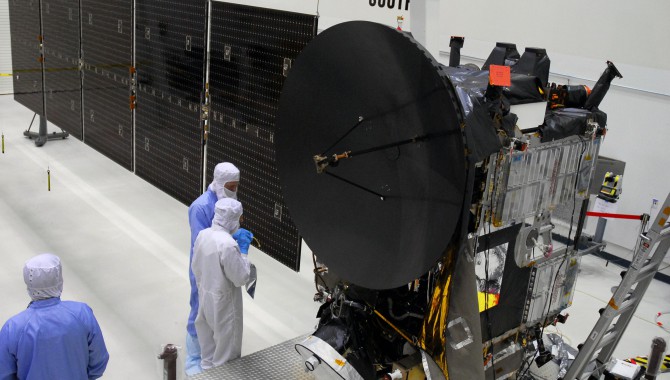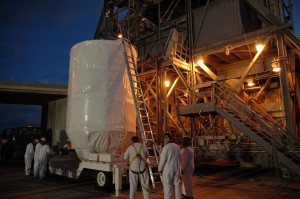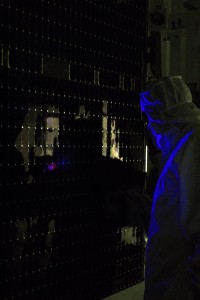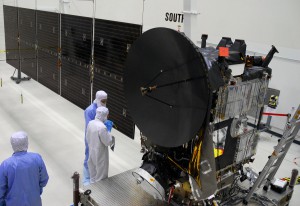
By Todd May
On September 27, 2007, a Delta II rocket carrying the Dawn spacecraft lifted off from Kennedy Space Center. Part of NASA’s Discovery program, the $370 million Dawn mission began its three-billion-mile voyage to the asteroid belt to study the asteroid Vesta and Ceres, a dwarf planet. The spacecraft is scheduled to reach Vesta in 2011. After spending nine months measuring the composition, shape, and topography of that body, it will travel a billion miles to carry out a similar analysis of Ceres in 2015.

NASA’s Dawn spacecraft arrives at Launch Pad 17B at Cape Canaveral Air Force Station
Photo Credit: NASA/Troy Cryder
As manager of NASA’s Discovery and New Frontiers program at Marshall Space Flight Center, I had oversight responsibility for Dawn, which the Jet Propulsion Laboratory (JPL) was managing while developing the spacecraft with Orbital Sciences Corporation. Over the years, Marshall has had a reputation for taking a command-and-control approach to program and project management: tell the project institutions or contractors what to do and, to a large extent, how to do it—end of story. When we formulated the Discovery and New Frontiers program, however, we decided to take a different tack. All our projects were developed either by JPL or Johns Hopkins University’s Applied Physics Laboratory (APL). We knew these organizations actually knew what to do and how to do it. While the responsibility for mission development lies squarely with the project, we in the program office could make real contributions to problem solving and decision making, and we could bring technical expertise to bear when needed. We would not impose Marshall’s specific set of “how-to” rules on them. Instead, we wanted to focus our energies almost entirely on enabling and supporting the success of these project teams.
We strove for trust and mutual respect, not control. It was an uphill battle at first, and there were some folks who frankly just didn’t trust our intentions. It took six months of demonstrating by our actions that we really were committed to this approach and were there to help. We had to earn their trust. I distinctly remember the day I knew the approach had worked. I walked into my office and found a yellow sticky note on my desk: Charles Elachi, director of JPL, wanted to talk to me. I picked up the phone and returned his call. He explained he had been a skeptic about the Discovery Program Office, but he had been won over by numerous reports from his staff and project managers that the office had helped them in some way.
Trust and cooperation build on each other; genuine cooperation creates more trust, which leads to more cooperation. Several months after that conversation, when APL ran into a late-breaking problem with their autonomy system on the New Horizons project (the onboard system for handling anomalies independent of instructions from mission operations), JPL offered up one of their most senior directors to lend a hand. He traveled to APL and stayed there for three weeks, rolled up his sleeves, and helped them solve the problem.
Ion Propulsion
Dawn’s long, complex journey is made possible by the spacecraft’s extremely efficient, futuristic ion propulsion system. Xenon ions expelled at high speed provide thrust. Their speed is high—about 25 miles per second—but their mass is low, so the amount of thrust is miniscule compared with conventional rocket engines. It is about the same force as that applied by a single sheet of typing paper resting on your hand. At full throttle, it would take one of Dawn’s three ion engines four days to accelerate the spacecraft from 0 to 60 miles per hour. But the engines can operate for extremely long periods of time. (They are expected to fire for more than five years over the course of the mission.) One of Dawn’s engines operating continuously for one year uses only fifteen gallons of fuel to increase the spacecraft’s speed by 5,500 miles per hour.
Deep Space 1, launched in 1998, was the first and only other NASA mission to use ion propulsion, so there were still technological and developmental hurdles to overcome for Dawn. Developing the system presented several engineering challenges that were also management challenges. One of the engineering challenges facing the JPL engineers working on Dawn was to understand the behavior of the nearly 1,000 pounds of xenon the engines required when the Delta II rocket’s third stage spun.

In a clean room at Astrotech, workers begin black light testing on the solar panels of the Dawn spacecraft
Photo Credit: NASA/George Shelton
Most spacecraft do not have difficulty sensing post-separation spin rates while the propellant and spacecraft are exchanging angular momentum. For Dawn, however, the heritage gyros of the spacecraft attitude control system saturated at too low a spin rate for this problem. Since a significant fraction of the flight system’s moment of inertia was in the xenon propellant, and given the low-saturation rate of the gyros, it was critical to mission success to understand the xenon spin behavior. If the attitude control system was activated while the gyros were saturated, the hydrazine propellant needed for the mission would have been expended in the first minutes of the mission, resulting in mission failure.
JPL engineers had no previous relevant experience to help them understand the potential problem. Success came from not simply identifying and assigning blame for the problem or taking control of it away from the group trying to solve it, but instead from focusing on how to help them succeed. The Discovery Program Office immediately offered engineers at Marshall a number of lessons about propellant slosh dynamics of superfluid helium learned while working on the Gravity Probe B project. This gave JPL engineers the support they needed to develop analysis and test techniques to resolve the problem.
Later, the xenon tank failed during qualification testing. The failure occurred just below the qualifying pressure, though—significantly higher than the nominal operating pressure. Focusing on the goal of mission success rather than the letter of the law of requirements, the Discovery Program Office grabbed pressure vessel experts and worked alongside the project to develop the recommendations and rationale to lower the operating pressure while maintaining mission performance requirements. This avoided the significant delay and expense redesigning, rebuilding, and requalifying the tank, which was already installed on the vehicle, would have caused.
Launch Delays
After a couple other assignments, I rejoined Dawn as deputy associate administrator for programs in NASA Headquarters’ Science Mission Directorate. In this role, I chaired the Program Management Council (PMC) that provided the recommendation to the associate administrator to proceed with final launch preparations. Dawn was scheduled for launch between June 20 and July 10, 2007, which, from four months out, seemed a reasonably generous launch window. Consequently, I was bullish on our ability to launch in this timeframe. After the PMC, I put out a press release announcing that we were “full steam ahead.” But as always seems to be the case, Murphy was right, and we learned the hard way how seemingly minor circumstances and delays can cascade into major problems. It’s like the old saying: “For want of a nail, the shoe was lost; for want of a shoe, the horse was lost; for want of a horse, the rider was lost …” and so on.
In Dawn’s case, what seemed like a relatively benign tenday slip in the delivery of the second stage fuel tank cascaded into what Steve Francois, the Launch Services Program manager at Kennedy Space Center, called “the perfect storm.” What happened? Here’s a sampling.
The P3 Orion surveillance aircraft, which was ready to provide telemetry during the original launch period, had another commitment during the new launch window dates. We purchased the services of a navy ship that could sail to the eastern Atlantic to receive the telemetry, but it had mechanical problems, ran into twelve-foot sea swells and unfavorable ocean currents, and failed to get to the location on schedule. We ordered up yet another telemetry aircraft, Big Crow, which also developed mechanical problems and could not get to its deployment station. We encountered a crane failure from a simple bearing that cost another week. Then there was the weather.

At Astrotech, workers check the Dawn spacecraft after testing the deployment of its more than 32-foot-long solar panels on one side.
Photo Credit: NASA/George Shelton
In July at the Cape it’s common for afternoon thunderstorms to develop and force transportation and fueling delays. We encountered a stationary weather front that sat on us for several weeks. Our slipping schedule began to impinge on the planned launch date for Phoenix, cutting into the time required between launches. Since Phoenix was a Mars mission, missing their launch window would cause an unacceptable two-year delay and cost hundreds of millions of dollars, so their schedule needed to take priority over ours. As we neared the fish-or-cut-bait point, the frequency and intensity of discussions increased dramatically. The odds were increasingly against successfully launching both Dawn and Phoenix within their windows. Discussions were elevated to the highest levels in the Agency, and our governance model was once again tested when there was disagreement as to whether the requirements for telemetry could be waived entirely. The right decision was made in the end, but it was a tough call. When the dust from “the perfect storm” settled, we ended up slipping the launch to a new window several months down the road at a cost of more than $25 million.
I drew two conclusions from this experience. One is a reinforcement of the need to maintain vigilance in examining the potential downstream repercussions of seemingly small issues. The other is that it is important to know when to fold ’em. You need to look at your situation realistically and objectively assess the risks without personal bias. When circumstances demand it, give up the effort to launch at the earliest possible date, as hard as that is to do and as much as that may feel like a failure. Temporarily standing down the Dawn launch was a tough decision, but it was the right one.
The Important Lessons
The demands of Dawn and other challenging missions I’ve been involved with have taught me some important lessons for successful program and project management. As far as I’m concerned, these are the main ones:
- Program management, particularly of uncoupled and loosely coupled projects, should be more about enabling than controlling. You’re working with motivated, highperforming teams and institutions with a track record of quality and success. Emphasize commander’s intent over rudder control; let them know where you want to go and when you want to be there, then let them figure out how to get there.
- Open and honest discussion of issues is essential. People fill the void of the unknown with their worst fears. Get folks around the table and have open, honest, and frank dialogue. I’ve seldom seen this fail to get to the root of issues.
- You have to earn your seat at the table, proving that you are competent, trustworthy, and dedicated to the success of the mission.
- Know when to fold ’em. Your pride can get rolled up in making a milestone or launch date, but you have to make a judgment based on the realities of the situation and not wear down the team trying to meet an increasingly impossible deadline.
- The NASA governance model that gives a voice to the concerns of engineers and safety experts works—trust it and use it.
Successful Launch
Dawn finally launched successfully—at dawn—on September 27, 2007. By November 14, while the spacecraft traveled away from Earth, controllers at JPL completed testing the ion propulsion system. The craft began long-term thrusting for its interplanetary travels in mid-December and will reach Vesta in a little fewer than four years.








